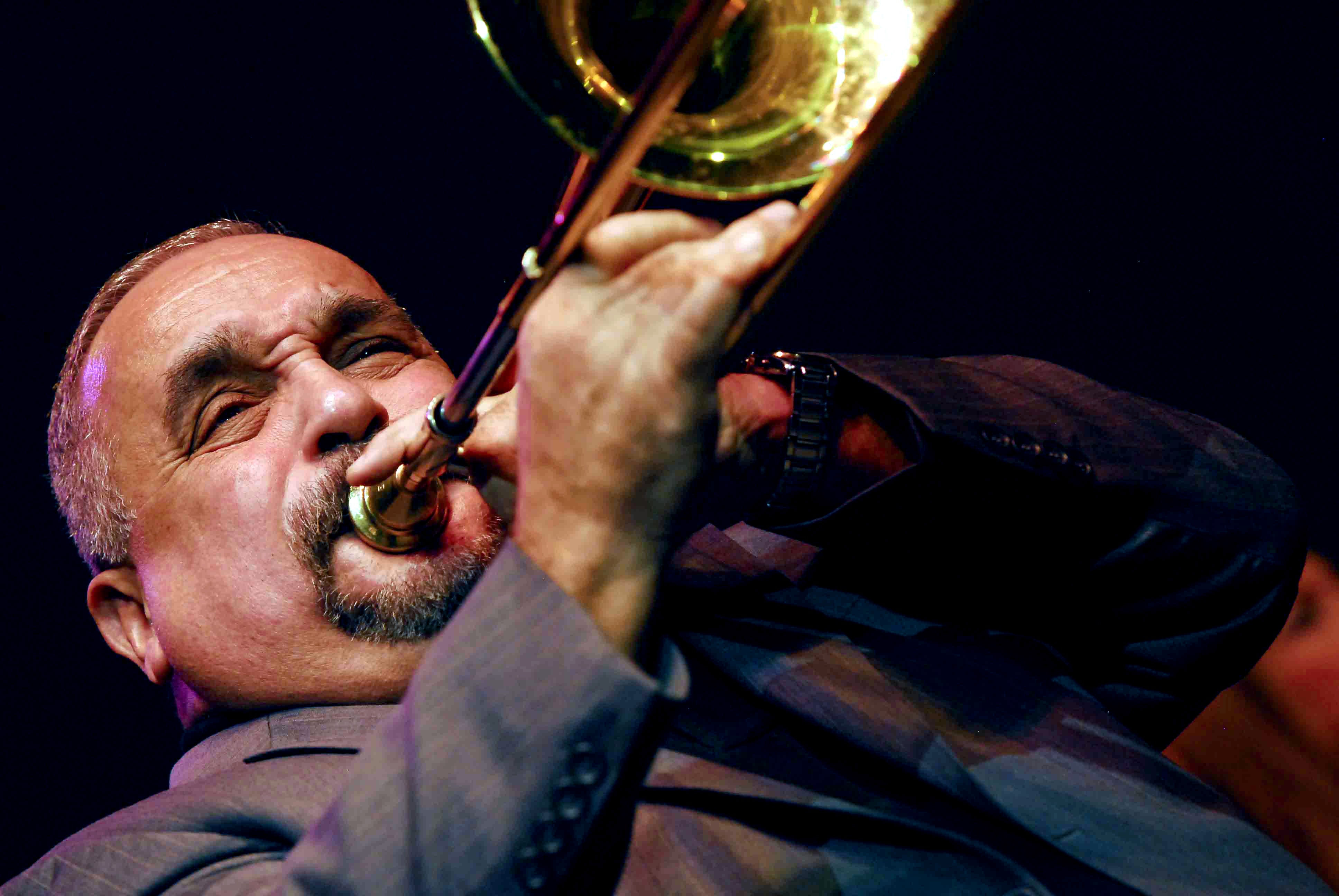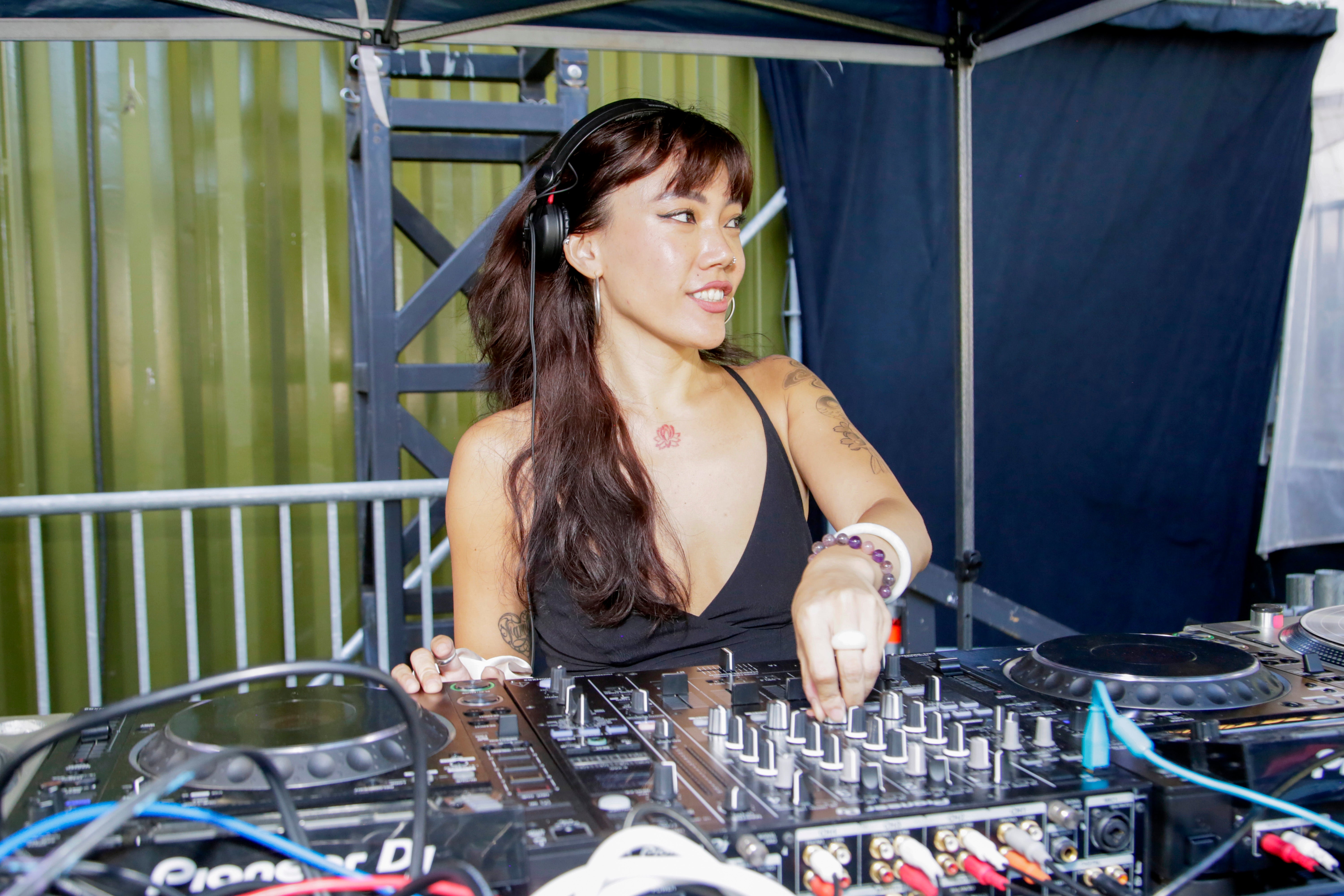
It’s a sunny spring afternoon in south London and a selector is slamming down some of the slinkiest salsa cuts outside of San Juan. This is one of the hottest tickets in town, a party put on by respected promoter Movimientos at the Fox & Firkin pub in Lewisham. Down the front, the serious dancers sashay effortlessly, while hipsters on the fringes have a go and try not to tread on each other’s toes. At the controls: Hong Kong-born Gia Fu, a DJ who’s bringing salsa to new audiences. Her YouTube mixes, where she plays old records on her home set-up, have had millions of views. She tours all over the world and has noticed the demographic at her sets changing lately. “It’s still a shock to me that everywhere I go, there are younger people,” she says.
In the UK and other places without deep Latin roots, salsa has long been associated with the Strictly ballroom, a way to spice up your marriage, or both. “It’s not even just a Western perception,” Fu, who discovered salsa music through a teenage breakdancing competition in Hong Kong, says over FaceTime. She heard Roberto Roena’s 1970 track “Que Se Sepa” over the speakers and it kickstarted a record-collecting obsession. “When I first started doing this, a lot of my friends thought it was kind of lame,” she admits. “I think the majority of people in Europe or in Asia, when they hear the word salsa, would immediately think of ballroom dancing.”
In its heyday, salsa was gritty: “music meant for dancing in seedy nightclubs,” said Rolling Stone. A heady stew of African-Caribbean musical styles and polyrhythmic traditions, it developed in the mid-Sixties in the vibrant immigrant neighbourhoods of New York City, among Latin and African-Caribbean musicians from Cuba, Puerto Rico and the Dominican Republic. This era also being big for rock’n’roll, jazz, R&B and beyond, salsa musicians referenced those popular genres too. Their lyrics often highlighted social injustice, oppression and resistance, as well as advocating for the empowerment of Latin communities and the diaspora. Until the mid-Seventies, it was boom time for salsa with Fania Records at the helm. The label’s leading names like Willie Colón, Héctor Lavoe and Celia Cruz – whose centenary is this year – were on a par with rock stars.
A bit like the disputed term “jazz”, salsa is less a rhythm or genre and more “a concept, the result of a way of approaching music from the Latin American cultural perspective”, Colón once said. Understandably, then, salsa spread back to the countries that inspired it, with regions like Cali in Colombia adding their own distinct flair. It had various mutations over the decades and briefly flirted with the mainstream once more in the mid-Nineties, thanks to artists like Marc Anthony (who famously played Lavoe in the 2006 biopic, El Cantante, where he also met Jennifer Lopez). But it never again reached the commercial heights of its opulent Seventies peak.
Until now, that is. Salsa is back in the spotlight, from cutting-edge clubs all the way up to the pop charts. At the start of 2025, Puerto Rican star Bad Bunny – who performed two O2 Arena shows in London last month – released his sixth studio album, Debí Tirar Más Fotos. Some of its tracks spliced salsa rhythms with his usual reggaeton beats and rap, and went to No 1 in the US, becoming the first salsa-inspired album to do so. After the dominance of reggaeton, “people want to hear music that’s real and heartfelt”, he told Billboard.
Fu was also back in London in June to play at a pop-up event to celebrate another Puerto Rican singer, Rauw Alejandro, and his album Cosa Nuestra. Released last November, its title (“our thing”) is named after an early 1969 Fania classic by Colón and Lavoe and is also the name of a 1971 film, Our Latin Thing, documenting the legendary concert at the Manhattan club Cheetah, given by The Fania All-Stars. Effectively salsa’s Woodstock, it was the gig that is said to have birthed the genre as we know it today. But Cosa Nuestra also references the softer, pop side of the genre that originated a bit later in the 1980s, known as salsa romántica. “I’m thinking about what it means to be Puerto Rican, our culture,” he told The Independent last year.

Another contemporary champion is Argentine-Spanish artist Nathy Peluso. Argentina is not a country known for having a strong salsa heritage, but Peluso’s “EROTIKA” track this year pays homage to salsa romántica. “Erotic salsa has a powerful energy. It’s visceral, body and desire,” says Peluso via email, adding that she listens to salsa every day. “I felt the need to reconnect with that universe where music becomes a carnal language.” Indeed, she steamily traces her dance partner’s six-pack in the music video. And now the greats are at it again, too – salsa, that is. Last month, Latin superstar Gloria Estefan returned with her first Spanish-language album in 18 years, flanked by the upbeat salsa single “La Vecina (No Sé Na’)”.
Streaming statistics back this salsa-naissance up. In March 2025, Spotify reported that its global salsa streams had surged more than 140 per cent in the past five years, “with US consumption nearly doubling”, and listeners aged 18-24 “now the second-largest demographic streaming salsa worldwide”. Beyond the foundational legends and the global stars like Bad Bunny and Alejandro, Spotify notes other artists like Puerto Rico’s Christian Alicea and Moa Rivera, Venezuela’s Jonathan Moly and Mexico’s Luis Vázquez who are mixing salsa with modern pop and even EDM production.
Salsa was born from the diaspora, from the meeting of worlds. It carries the soul of Latin America
There’s also a growing audience for salsa events and shows. The Latin American Bureau reports that Latin Americans are one of the fastest-growing migrant and ethnic groups in London and across the UK, increasing by 395 per cent between 2001 and 2021. Andy Wood, who set up London Latin music promoters Como No and festival La Linea, says: “Latin music is enjoying a boom globally and the growing Latin American population in the UK is having an impact, both in terms of audiences and of music creators, dancers and DJs,” he says. “Salsa is moving forwards in London and not just because of Bad Bunny – a couple of weeks ago, we had a packed house at the Electric Brixton for Cuban great Alexander Abreu and Havana D’Primera who mixes salsa with Cuban timba, [which is also] taking the music in new directions.”
Of course, for many people in the Latinx community, especially in regions where salsa originated or flourished, the genre’s potency has never dimmed. It remains a deeply important part of cultural life, a vital means of expression and a way for people to connect. “Salsa has always been a genre of the people,” Bruce McIntosh, vice president at Craft Recordings – which owns the Fania Records catalogue – told TIME. “Even when its peak commercial trend had waned, it remained strong in various countries, communities, clubs and households.”
But today there seems to be a renewed appreciation for its cultural significance and legacy, especially from newer generations. “Because it’s [about] identity and roots,” says Peluso. “Salsa was born from the diaspora, from the meeting of worlds. It carries the soul of Latin America. And today, Latin music is at its peak; it’s winning over listeners in every corner of the world. Showcasing salsa in that context means showing an essential part of who we are. Salsa is truth, it’s the streets, it’s romance, it’s strength.” Ana Lucia, aka Coco María, a Mexican DJ, NTS radio host and label owner based in Amsterdam, who sprinkles salsa in her globe-trotting vinyl sets, agrees: “For the Latin American community, in the US especially”, salsa music “gives them a lot of strength and belonging and purpose. Real salsa people are very serious about it. It’s a whole universe, with a great history and great musicians.”

It used to be the case that if you wanted to hear lots of salsa on this side of the Atlantic, you had to go to a Latin party, says Lucia. But in recent years that’s changed. “I’ve noticed it especially over the last couple of years. When I first moved to Europe, the only places where I would hear salsa was at Latin parties, or in a Latin restaurant, or specific places for Latin people, never outside. Once in a while you heard Buena Vista Social Club” – incidentally, the cast of the 1999 documentary about the musical ensemble has just performed on hugely influential video series Tiny Desk – “but that was about it. Now you can hear a salsa track and it’s not at a Latin party specifically, or a Latin person playing it, or only Latin people dancing. That’s new.”
There’s been a perception from some non-Latin audiences in the past, she says, that salsa is “kitschy” and if she played a record then they might see it as an opportunity to dance as if they found it “funny”, rather than a meaningful cultural or political expression. But these days, “I feel like people understand it much more,” says Lucia. After all, this is a musical style that deserves great respect. “I can play it almost everywhere and people feel it,” she continues. “People don’t react like I’m playing something strange.”
Part of salsa’s growing popularity, says Lucia, is that it’s accessible like never before. “It’s more available, more in the wild.” No longer confined to out-of-print wax in the dusty record collections of the few, online radio shows, album reissues and compilations have played a “strong” role in spreading salsa to new audiences and have laid the groundwork for a record like Bad Bunny’s to be appreciated more widely, she adds. “There was already something being built, so it’s easier for audiences to hear and digest. I think that was shaped thanks to the selectors playing these records constantly.” To get the party started, she’ll stick on something by Puerto Rican salsa troupe La Sonora Ponceña, a historic band who’ve been active since 1954, “because they’re very jazzy and have a lot of instrumental songs – it works everywhere I play”.

Similarly, Fu spins selections that can work with her increasingly diverse crowd – “salsa from New York, from Puerto Rico, Venezuela, Colombia, China, Japan, all kinds of stuff”, she says. Hang on, China? “It’s not just salsa in Spanish,” she says. Fu has started a project and party, Canton Mambo, “dedicated to bridging cultural gaps” and exploring the links between African-Latin and east Asian music. The DJ, who studied Spanish at university so she could understand the lyrics of her favourite salsa songs, notes how her mother, a dance teacher, grew up in China listening to mambo and cha-cha, styles that predated salsa, while salsa would later come through the ports of Hong Kong and inspire the musicians based there. “The Latin influence on east Asia records is very important,” she says.
Today, salsa cuts across musical spheres, from new jazz to electronic. The Latin-American music website Remezcla noted how, in Puerto Rico, young people are forming salsa orchestras. Likewise, in London, the 18-strong New Regency Orchestra draws on African-Cuban salsa, mambo and rumba and has played venues like the Jazz Cafe. The band’s curator, Lex Blondin, one of the linchpins of the London jazz scene, saw an opportunity to blend worlds. “We connected with the Latin community in London and all the great players and merged them with all the jazz musicians from London,” he explains. “For some of the players, it’s the first time they’ve worked in this kind of music, which is exciting. It was a way to champion this music and give it a new lease of life.”
New Regency Orchestra released their self-titled debut album in June 2024 and have been putting out remixes, where up-and-coming producers turn their tracks into salsa bangers. There’s a growing appetite for those too: one of the biggest UK electronic music producers, Barry Can’t Swim, sampled Celia Cruz and Johnny Pacheco’s 1974 song “Quimbara” for his track “Kimbara”, 50 years later. Chilean producer Paula Tape’s recent Acid Latino EP, meanwhile, blended 303 basslines with salsa flourishes. And independent dance labels like Toy Tonics have been quick to release EPs that foreground Spanish language lyrics and Latin rhythms. “I think, in general, Latin or Hispanic culture is in a moment where it’s very popular,” says Lucia. “You don’t have to speak a language to enjoy a song.”
You don’t have to know the steps either, assures Fu, and you can leave the sequins at home. “Salsa dancing came from street dancing,” she says, echoing Peluso. “They started off dancing on the streets in Cuba, in the Bronx, all these places.” While she notes that the stereotypical perception of salsa is “the ‘show’ type, with crazy routines”, lots of people come to her parties who want to express themselves and enjoy the music, whether they’ve got a dancing partner or not. In any case, Fu has a solution: “Just let it move your body.”
Follow Gia Fu’s tour dates via her Instagram page; Nathy Peluso’s CLUB GRASA remix album is out now
For details of all upcoming Como No concerts, see www.comono.co.uk and for Movimientos events, see www.movimientos.org.uk
Bad Bunny uses recording mimicking Trump in new music video
Public Enemy’s Chuck D: ‘Bob Vylan ain’t got no tanks’
Oasis are the ultimate Nineties band - there is a good reason Gen Z love them today
From Champagne Supernova to The Masterplan: The 20 best Oasis songs, ranked
Music critics say Oasis only made two good albums. Gen Z strongly disagree
Metallica, Alice in Chains, Sammy Hagar and Yungblud on Black Sabbath’s farewell show







